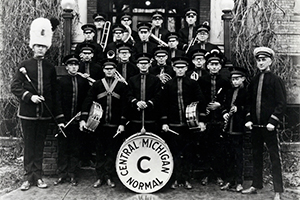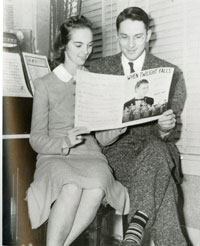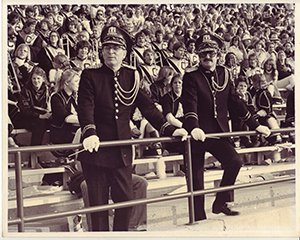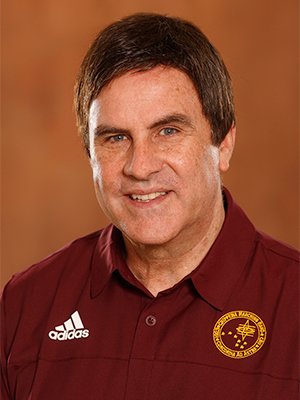History of the Marching Band

The Central Normal Band was formed in the spring of 1918, a year after the United States entered World War I, when the US War Department established the Students' Army Training Corps. The band served several patriotic and military functions, but after the war, interest waned. In Fall 1923, Music Department Head J. Harold Powers enlisted sixteen men and boys, funded the purchase of uniforms, and took on director duties. Registrar and Dean of Men Charles C. Barnes lent support for the new group by donning a uniform himself and acting as honorary Drum Major.
The band was immediately embraced by the campus community in response to its enthusiastic support of the football team. According to the Chippewa Yearbook from that year,
The band helped immensely to add color to the games and to keep the spirit of the spectators, as well as the team, at a maximum. Let us hope that the band will continue to give added zest to the social and athletic endeavors of Central and that the bands of later years will continue to maintain the high standards set by the present organization of splendid musicians.


In 1926, Professor Powers and new band director William Seddon bolstered participation by permitting women to be eligible for membership. New uniforms and equipment were purchased and the band's enrollment grew to twenty-six. The position of director was filled by several talented men over the next few years. Mathematics Professor Cleon C. Richtmeyer led the band in 1927-28 and then played in the trumpet section under Clarence L. Kelley (1928-29), and Newell H. Long, the CBM's 5th director (1929-30). Professor Long went on to be a long serving director of bands and music administrator at Indiana University and was a prolific editor of music for low brass - notably the Rubank Band Method books.
In the fall of 1931, Preston Mayhew became the first Central graduate to lead the band program, having graduated the previous spring. As a student, Mayhew had played Baritone in the CSTC Band and moved between Clarinet and Horn in the Orchestra. In his first year as Director, he established the 40-piece Central Marching Band as a separate, all male group. Both men and women continued to enroll in the Concert Band. In 1934-35 Mayhew reorganized the band as a student club, "in order to foster better cooperation" among its members. Mayhew's innovations and teaching style were immediately popular with students and audiences alike. He led the program to regional acclaim and began a tradition of extended leadership, serving as Director for fifteen years, the first of only four directors to hold the position since.

By the end of the 1930s, the Band Club had become a leadership group comprised of band lettermen. Women were admitted to the Club in 1940, though no provision was made for them to the letter for several years. In Fall 1942 women were once again admitted to membership in the ranks of the CMB and were receiving varsity letters by the end of the 1943 season. The band remained "co-ed" for the next twenty years.
The 1941 Chippewa Yearbook hailed Norman C. Dietz and Margaret Bush as model students. In addition to their exemplary work as band members, "Norm and Peg" led the campus community - Norm as student body president and Peg as President of the Women's League - with an unparalleled devotion to service. After graduation, marriage to Peg, and service as an Army bandsman during the Second World War, Mr. Dietz returned as Director of Bands at Central in Fall 1946. Under his leadership, Central's band program would flourish and attain national recognition for excellence and innovation.


In 1948 Mr. Dietz successfully petitioned to be granted a leave of absence to pursue graduate studies that would lead to tenure and professorship on the faculty. For the 1948-49 school year, Rex Hewlett replaced Mr. Dietz as director of the Central and Mt. Pleasant High School bands. The two positions were permanently separated upon Mr. Dietz's return to Central in Fall 1949, and Mr. Hewlett continued as director at Mt. Pleasant HS. The look and sound of the band became well-known, drawing invitations to perform televised for the Chicago Cardinals and Bears.
When Central Michigan University was named in 1959, the CMU Bands began to grow significantly. Drs. William Rivard and Edgar Ross had been recruited by Mr. Dietz to expand Central's instrumental music faculty and to provide for the growth of the Music Department. Dr. Ross took on the instruction of woodwind students. Dr. Rivard served as brass specialist and Assistant Director of Bands. In Fall 1959, the Chippewa Marching Band grew to over one hundred members for the first time. That same year, Mr. Dietz established the Symphonic Wind Ensemble after the example of his long-time friend and colleague Frederick Fennell, founder of the wind ensemble concept at the Eastman School of Music. Dr. Rivard took over as conductor of the Concert Band. As the program grew to the point when applied teachers were needed for all instruments, Dr. Rivard became a Professor of Trombone, and Dr. Ross became a Professor of Clarinet.


In 1962, Mr. Dietz decided to once again restrict membership in the Chippewa Marching Band to men only. The move sparked some minor controversy on campus but was generally accepted. Euphonium player Mary Kinsman joined the band in 1973, and women have since become integral to the CMB's growth and leadership. Mr. Dietz continued as Director of Bands until his retirement in 1979.
Beginning in 1956, the CMB was led on the field by the only student to serve four years and the entirety of his undergraduate career as drum major - Jack Saunders. Both Mr. Dietz and Mrs. Rozi Saunders report that among the initial reasons for Jack's appointment to the position as a freshman was that he fit the uniform. Nevertheless, Jack quickly distinguished himself as a leader on and off the field. After graduation in 1960 and immediate success in the public schools, Jack returned to CMU as a graduate student and, in 1965, assumed the position of assistant to Mr. Dietz.
Professors Saunders and Dietz expanded the size, quality, and influence of the CMU Bands. Nationally televised appearances at CMU games, bowl appearances, and invited performances for the Detroit Lions drew praise from alumni, fans, and seasoned network sportscasters alike. Jack's familiarity with traditional styles and his appreciation for the creative excellence of the drum and bugle corps movement combined to produce a singular approach that moved the CMB to the cutting edge of "corps style" design and technique, making it one of the first American college bands - and the first in Michigan - to do so. In addition to his work with the CMB, Professor Saunders taught horn, played in both the faculty woodwind and brass quintets, and developed the CMU Jazz program. Under his direction, the Concert Band split into two groups, the Maroon and Gold bands. Jack's reputation as a musician, designer, and innovator grew quickly. By the 1970's Jack was in great demand as a clinician and adjudicator for bands across the United States. In 1978, Mr. Dietz named Jack director of the CMB. In 1981 the band fielded more than 200 members for the first time. By the time Jack retired in 2000, three full-time faculty had to be hired to take on all his duties. When Jack passed away suddenly in 2005, the Chippewa Marching Band followed him one last time through the streets of Mount Pleasant to his final rest.


Beginning in the fall of 1979, John E. Williamson was CMU's longest-serving Director of Bands. Before coming to Central, Williamson was a highly successful teacher at Wheeling High School in Illinois. His wind ensemble gained national recognition due to its unique programming and performances across the United States. The Sousa Foundation honored the Wheeling program as one of the nation's finest, with Mr. Williamson receiving the coveted Sudler Award. Working together with Professor Saunders, Mr. Williamson continued to develop and refine the sound of the Chippewa Marching Band.
Under Professor Williamson's direction, the Symphonic Wind Ensemble performed for the Midwestern Conference on Music Education, the Midwest Clinic in Chicago, regional and national conferences of the Music Educators National Conference (MENC) and the College Band Directors National Association (CBDNA), and in historic Carnegie Hall, New York. He has been an active adjudicator, clinician, and guest conductor in the U.S., Canada, Mexico, Europe, and Australia. Professor Williamson is a member of the prestigious American Bandmasters Association, the National Band Association, Kappa Kappa Psi, and Phi Mu Alpha Sinfonia. He has held offices in CBDNA and led the commissioning project for the Mid-American Conference Band Directors Association. In addition to being listed in the International Who's Who in Music, he has received the NBA Citation of Excellence and was the first Illinois director to receive the MAC Award from the First Chair of America. He has been presented with CMU's Excellence in Teaching Award and the Orpheus Award from Phi Mu Alpha Sinfonia. Professor Williamson has been a new music reviewer for The Instrumentalist, BD Guide, and Band magazines and is co-author of "Strategies for Teaching High School Band," published by MENC. His book, Rehearsing the Band, has become a standard industry reference in multiple international translations and has spawned two additional volumes.
Upon Professor Williamson's retirement from CMU in 2018, alumni, colleagues, and friends formed two separate consortia to commission works in his honor, both of which have received immediate acclaim. Williamson's long-time CMU colleague and friend David Gillingham produced his Adagio for Winds and Percussion, and CMU grad David Biedenbender's Symphony for Winds and Percussion: What Is Written On The Leaves, was featured at three world premiere events, including a performance at the 2019 CBDNA national conference.

In 2000, yet another CMB alumnus returned to lead the band. James Batcheller, Drum Major from 1981 to 1983, brings a broad range of experience to his job as the ninth director of the CMU Marching Band. Dr. Batcheller holds advanced degrees in conducting from the Florida State University and the University of Oklahoma. His Great Falls High School Bands in the state of Montana earned praise from clinicians, adjudicators, guest conductors, and composers, including Eric Stokes, Eric Ewazen, Daniel Bukvich, David Holsinger, Eugene Corporon, and William Wakefield. As a visiting faculty member at the University of Oklahoma, Professor Batcheller served as coordinator of Instrumental Music Education and conductor of the Wind Symphony and Symphony Band. An advocate for new art music for wind band, he conducted the premiere of Charles Rochester Young's Tempered Steel, the inaugural commission of the Big 12 Band Directors Association, and Glory by CMU's own Rob Ash. Dr. Batcheller was among the commissioners and premier conductors of Frank Ticheli's Symphony No. 2. He has given presentations and conducted performances at the Southwest, North Central, and National meetings of the College Band Directors National Association and has published articles in the Journal of Band Research and the Instrumentalist magazine, and is a contributing researcher for the Teaching Music Through Performance In Band series of reference books. New orchestrations by Dr. Batcheller have been performed by stars of opera and the Broadway stage, including Darius de Haas, Sarah Uriarte Berry, and CMU's own Teri Hansen, and by ensembles including the Colorado Symphony Orchestra. Dr. Batcheller is active as a clinician, adjudicator, and guest conductor across the United States. His extensive background in marching band and drum and bugle corps includes experience as Director of Drum Corps International Championship finalists SPIRIT from Jacksonville, Alabama, and as a staff member and show designer for the famed Pride of Oklahoma marching band.
As Associate Director of Bands and Professor of Music, Batcheller conducts the Wind Symphony and teaches courses in Conducting and Instrumental Music Education. As Director of the Chippewa Marching Band, he has furthered the efforts and expanded the traditions of innovation and excellence established by his predecessors. Working with coaches and officials in the Department of Athletics, Batcheller has expanded the strong relationship between the band and football team. Each summer at the start of two-a-day practices, Batcheller speaks to the team and assists the upperclassmen in teaching new football recruits the CMU Fight Song. Each fall the band, team, coaches, and staff members meet in closed sessions to fire up for the start of the new season. Special musical arrangements, creative show design, and powerful performances continue to inspire enthusiastic responses from audiences at home and off-campus. The band continues to receive high praise for performances at special events for Bands of America, the Detroit Lions, and in support of Chippewa Football at conference championships and bowl games. In 2003 the band's membership exceeded 250 for the first time.

In 2018, the CMU Bands were again led by a distinguished alumnus as interim Director. John Allen Campbell received the Bachelor of Music Education degree from CMU in 1973 and the Master of Music Education degree from Michigan State University in 1985. He taught high school bands in Michigan for 26 years, serving as Director of Bands at Brablec High School in Roseville (1974-1976), East Lansing High School (1976-1980), and Traverse City High School (1980-1996 and 2002-2006). He returned from retirement in 2016 to teach at Traverse City while the search for a new permanent band director was conducted. Professor Campbell has served in summer and interim positions as Assistant Director of Bands at Wayne State University, Community Band Director for the East Lansing Fine Arts Program, Percussion and Jazz Instructor at the Interlochen Fine Arts Summer Music Camp, Symphony Band Director at Michigan State University, and Youth Music Program Executive Director for Michigan Ambassadors of Music European Tours. From 1993-1997 Professor Campbell served as Music Director /Choral Director for the First Congregational Church in Traverse City and from 2002-2012 as the Choral Director at Traverse Bay United Methodist Church. Professor Campbell was Michigan School Band and Orchestra vice-president for jazz, district vice-president for band, orchestra, and jazz, and co-chair for the MSBOA District II Honor Band. He has received the prestigious American School Band Directors Association Stanbury Award as Outstanding Young Band Director in the United States (1981), the MSBOA Michigan Teacher of the Year award (1982), and the Traverse City Area Chamber of Commerce Excellence in Education Award (1987). Under Professor Campbell's leadership, the Symphonic Wind Ensemble and all our bands continued to flourish through the Spring of 2019.
Dr. Christopher Chapman joined us as Director of Bands in fall 2019. Most recently, Dr. Chapman has been director of bands at Oregon State University, where he conducted the Wind Ensemble and Chamber Winds, guided all aspects of the program and also coordinated the wind band conducting area. Under his direction, the OSU Band Program gained praise from composers and audiences alike. Under his baton, the OSU Wind Ensemble has toured extensively both domestically and abroad and has been featured in performances from Carnegie Hall in New York City to concert halls on the west coast of the United States and overseas in Japan and Taiwan. Their commercial recording projects include "The Five Changes," "Currents," David Maslanka's "Mass," and "Scenic Meditations" featuring the Boston Brass.

Originally from Columbus, Ohio, Professor Chapman holds degrees in music from The Ohio State University, the University of Nevada, Las Vegas, and the University of Washington. He has appeared as a conductor, clinician, and lecturer throughout the United States. He has also been a contributing author in "A Composer's Insight: Thoughts, Analysis and Commentary on Contemporary Masterpieces for Wind Band," a series of books on contemporary wind band composers, and "Teaching Music through Performance" by GIA Publications. Dr. Chapman's wind band compositions and arrangements are widely performed across the United States.
In 2015, Dr. Chapman was elected to the prestigious American Bandmasters Association. He has been the Northwest Division president of the College Band Directors National Association, Northwest Divisional Chair of the National Band Association, and an inductee into the Phi Beta Mu honorary Bandmasters Fraternity. He is an honorary member of the Tau Beta Sigma Honorary Band Sorority, and Kappa Kappa Psi Honorary Band Fraternity, for which he has served as the Co-Governor of the Western District. Other memberships include the World Association of Symphonic Bands and Ensembles, Oregon Band Directors Association, National Association for Music Educators, and Oregon Music Educators Association. Chapman has also served as the musical director of the Oregon Brass Society, a British-style brass band in Springfield, Oregon, and the Portland Wind Symphony, a professional adult band based in Portland, Oregon.
As we continue to celebrate over a century of band tradition, students and alumni can look forward to continued advancements and innovation, as have been our tradition throughout our history, with an appreciation for those who paved the way, and for the benefit of those who will follow.
